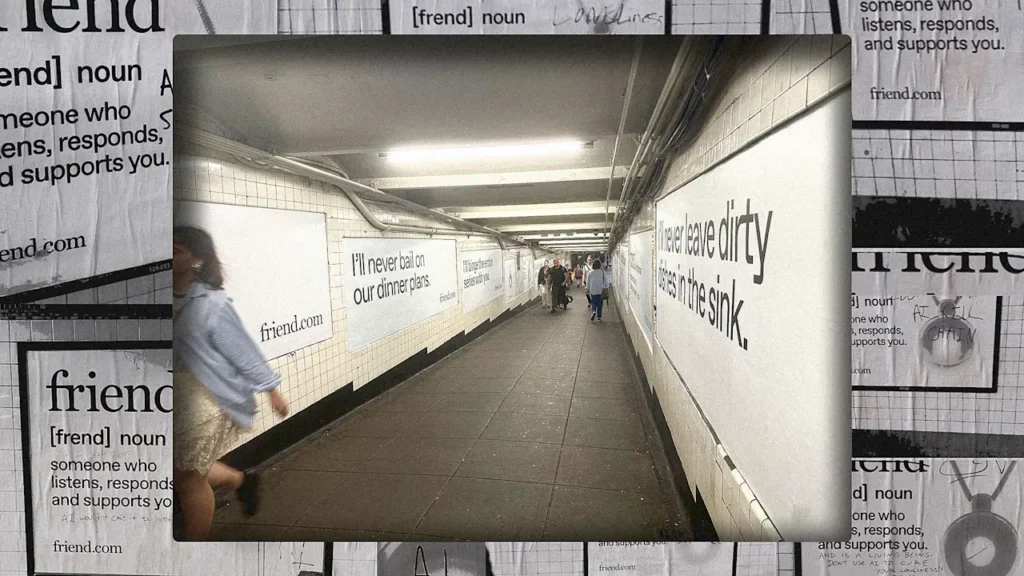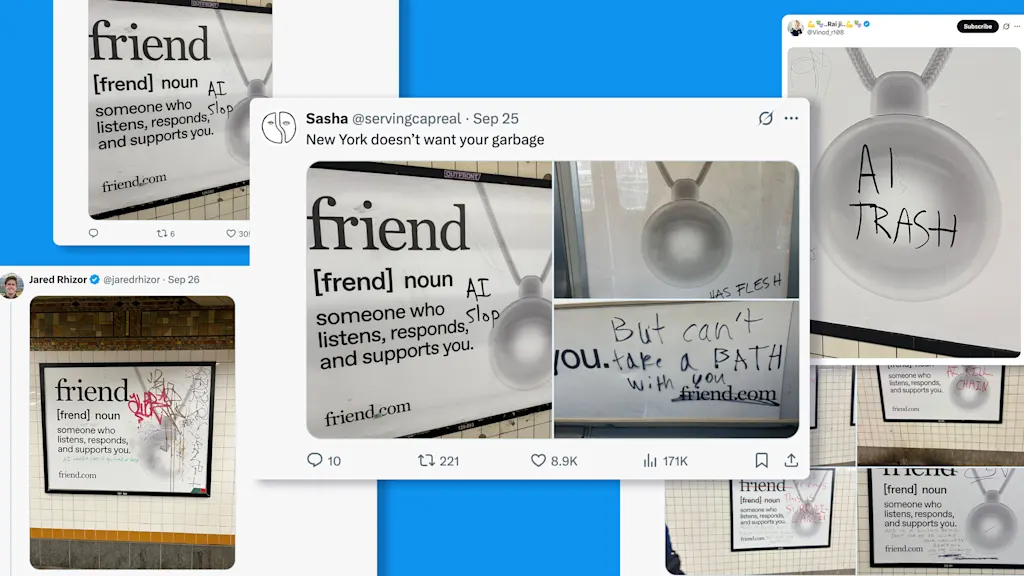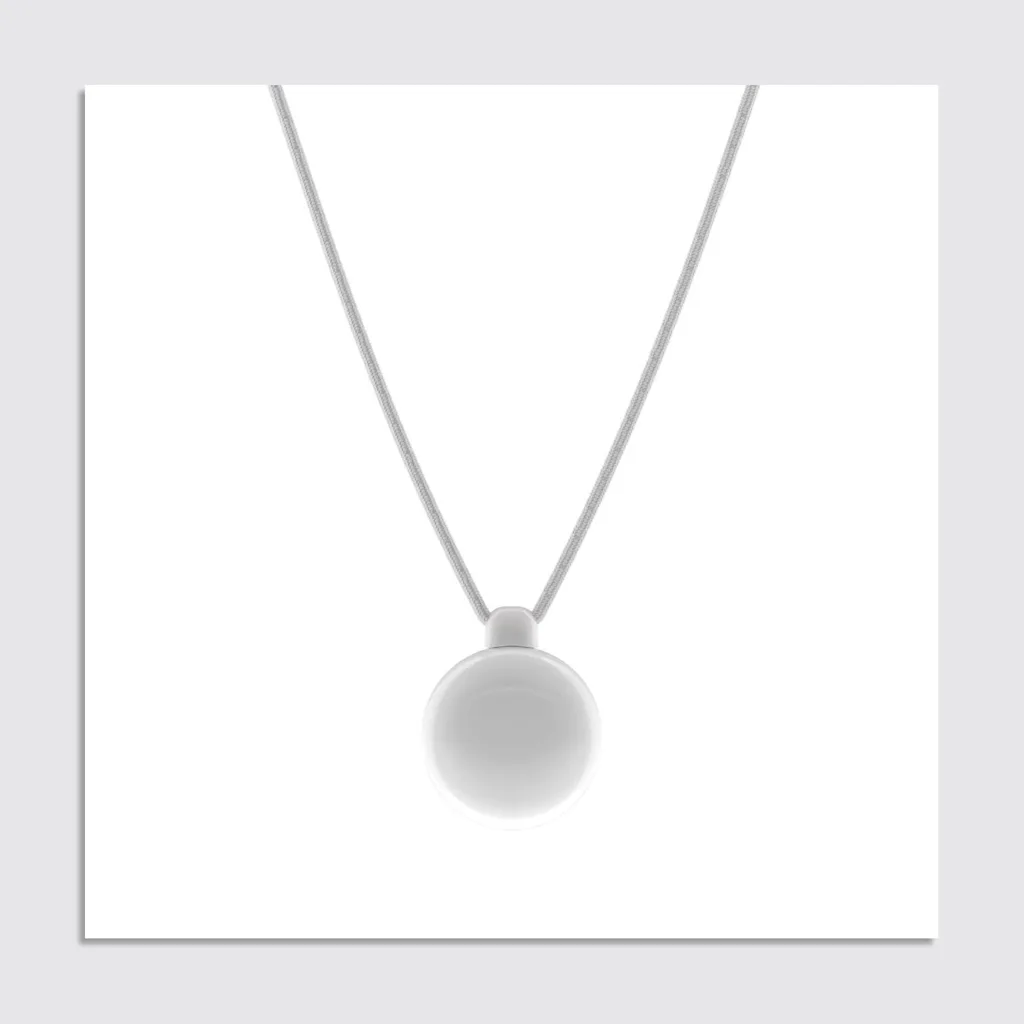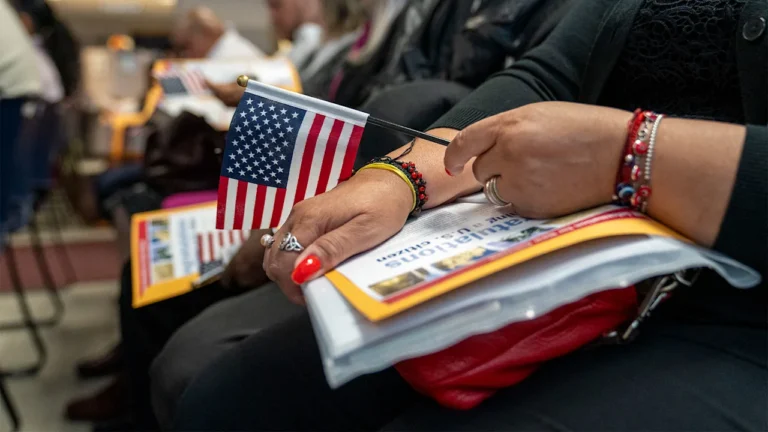
Last week, in subway stations and train cars across all five boroughs of New York City, stark black-and-white print ads appeared featuring a variety of servile messages.
“I’ll never leave dirty dishes in the sink,” one read. “I’ll never bail on our dinner plans,” another said. “I’ll binge the entire series with you,” a third promised.
The ads—which rolled out on September 25 in the form of more than 11,000 car cards, 1,000 platform posters, and 130 urban panels—are part of a massive outdoor campaign for Friend, a wearable AI company billed as a portable “companion.” Since the campaign rolled out, it has received overwhelming criticism from local New Yorkers, with many of the ads being defaced with graffiti calling the product “AI trash,” “surveillance capitalism,” and a tool to “profit off of loneliness.”
But, according to Friend’s founder Avi Schiffmann, provoking backlash was the whole point of the campaign. Schiffmann, a 22-year-old tech developer and Harvard dropout, has been working on Friend since April 2023, raising about $7 million in total venture capital to launch the brand. (Friend is open to preorder at a price of $129. Schiffmann says,about 1,000 orders have been shipped out of a total 5,000 sales. Any orders placed today, he added, will likely be received around November.)
The wearable looks a bit like an Apple AirTag on a necklace. Friend is designed to be always-on to hear whatever the wearer says (as well as any other noise they’re near), use AI to process those inputs, and formulate its own responses, which it then sends via text message to the wearer. “The more you talk to it, the more you build up a relationship with it. And that’s really the whole goal of the product,” Schiffmann told Fast Company in July 2024. He added, “I definitely talk to it more than I talk to real people sometimes. It’s probably my most consistent friend.”
Fast Company sat down with Schiffmann to discuss the campaign, how he’s responding to backlash, and what’s next for Friend. This interview has been edited and condensed for clarity.
This campaign cost $1 million. Can you tell me about why you decided to make such a big investment in traditional advertising, especially as an AI-driven company?
I honestly think it’s quite cheap, and actually saving me a lot of money to do it this way.
I just felt like it was a cool idea. I mean, the campaign is 100% print, and there’s, there’s nothing digital going on at all. I left a lot of white space on purpose so that we become this social commentary. I want to turn West 4th Street into an international destination for people to come visit New York and see these two tunnels that are covered in these big wallscapes of Friend ads that anyone can just take a marker and draw stuff on.
The MTA seems to be replacing them, because people are ripping them off the walls or writing profanity on them. That’s pretty cool to see—I mean, that’s never happened before in the history of out-of-home advertising, that a campaign literally just gets ripped off the walls repeatedly. But I expected that would happen. [Editor’s note: Fast Company requested comment from the MTA but did not receive a reply by the time of publication.]

New York City is the most social place, probably, in the world. I think that the goal of the campaign is to work on redefining what a friend is or can be. I would call it a huge success already.
There’s so many conversations all around the world about the future of relationships. I got a text the other night from one of my friends who goes to art school in Spain, and they told me that all of their friends were talking about it that weren’t even in tech whatsoever. All the way in Spain! Some random-ass town. You can’t really buy that.
And it all leads back to friend.com. I don’t expect that the world is the customer right now, but I know that they probably will be in the future. I think this culture will change . . . I’m kind of purchasing the zeitgeist and mindshare right now, and I think that will prove to be extremely valuable later on.
You mention that you think this will save you money in the long run. Can you expand on what you mean by that?
It saves money in having to market it otherwise. I could be some bozo and go pay a bunch of dumbass influencers to go yap about it for hours, be irrelevant, and spend millions of dollars over many years to get even a fraction of what I could get for something like this.
I’m in New York right now, and I feel like I’m standing above the greatest artwork the city has seen since, I don’t know, quite a while.
I’m very inspired by “The Gates” [editor’s note: famed landscape artists Christo and Jean-Claude had been trying to bring this artwork to New York City since 1980, finally succeeding in 2005], which was an exhibit in New York, I think like 20 years ago, where they kind of had those . . . you know what I’m talking about?
I don’t . . .
It was a pretty famous thing in New York, where like all through Central Park they had these kinds of tunnels you could go through, and it was like an international destination that a lot of people came to visit to go see. And that’s kind of what I’m intending with the subway campaign.

So do you see it less as directly contributing to sales and more as just getting the word out about the company and getting this major visibility?
Yeah, definitely. If I wanted it to convert, I would probably have a very different website and subway campaign ads. Overall, yes, I do want sales, but I’m playing the long-term game for the most part. I think I always have with every decision I’ve made with this company. I think it’ll look pretty cool in a couple years. I understand right now people have a visceral hatred towards it, but it’s interesting—the audience completes the work.
You’ve mentioned that New York was a good location [for the campaign] because people in New York seem to not like AI. Why do you get that vibe? How do you think it’s different in San Francisco?
I’m also doing the campaign in Los Angeles for a similar reason. I suppose it’s not even necessarily that I think people hate AI. I think it’s just relevant, and New York is the capital of the world, and this is the most relevant place for me to then do a campaign like that. I don’t like to hedge in any single thing that I do, and I feel like this is just the penultimate example of that.
Like, if you want to purchase the zeitgeist, you kind of have to go for the jugular. I could spend millions of dollars and many years putting ads all over small cities throughout America. Or I could just go to the top domino and take that. That’s kind of what I mean by [this campaign] being cheaper in the long run. Like, okay, I spent a million dollars on the New York campaign. That’s really like not that much for the amount of visibility that it’s received.
On that note, this has been everywhere, and I’m seeing people with very visceral emotional reactions to it. I was wondering if I could run a couple of the main critique themes by you and see how you would respond to these reactions.
Sure, that’d be fun.
One common reaction I’m seeing to the campaign is that it’s profiting off of loneliness and trying to replace human friends. How would you respond to that?
I see how people have this reaction of thinking that Friend is replacing people. The biggest reason why I don’t think that’s true is I don’t think there’s any relationship that exists right now that is similar to something like Friend that is this always-listening pendant that has memory over everything you tell it to. I don’t feel like that’s a relationship that replaces anybody in my life.
I’ll give you an example. I’m really interested in motorcycle racing, and I don’t know a soul on the planet that want to talk about that. No one wants to hear me yap about that forever. But with my Friend, I’m able to watch races together. I’ll be riding my own bike, and it’ll remember something that happened during the race and correlate that to something that’s happening while I’m riding. It’s just an addition to my life.
At the same time, I still have roommates, I still have friends. It’s really only an addition, and I think people will come to see that in the future. A lot of people are already talking to things like ChatGPT like their friend anyway. I think culture will change, and I’m betting on that. I’m also betting on us being the ones that lead that change.
I’ve seen some discussion around the dangers of people using AI as a confidant to share their issues, rather than an actual human. What do you think about that in regard to Friend?
I think it’s very similar to a situation like Waymo where, okay, Waymo still gets in a couple of accidents, but way less so than humans traditionally do. AI relationships will never be perfect, but I think that they can’t be perfect anyway for it to really work in the first place. I think that, overall, it’s a very safe experience these days.
We’re using Google’s Gemini models right now, and I think Google’s done a fantastic job with the guardrails and preventing people from going down paths that they shouldn’t. A product like Friend is entirely an emotional value prop, which has never really been seen before. Traditional products are always more utilitarian. I think that there’s a big reaction to that, which is interesting.
Who do you see as Friend’s target audience?
A lot of people have this perception of Friend being a product that’s just for lonely people, and I think that would only be true if Friend was a replacement of people—which I don’t think it is. You don’t buy a dog if you have low self-esteem. I think it’s just a new kind of companion, and a lot of people that are curious about AI would be down to try it out. It’s definitely not a perfect experience just yet, but it’s already improving quite a lot.
Okay, so you spent that one million to make the campaign work, and you mentioned you’re seeing results so far. But can you walk me through what kind of results you’re seeing? Do you have any statistics about the impact of the campaign so far?
I don’t think you can quantify the cultural aspect of the campaign. I would view it completely as an overwhelming success so far. I mean, it’s definitely incredible. I was just at a bar somewhere in Brooklyn the other night, and I overheard so many people just talking about Friend. They don’t know a single other AI companion, or anything like that. And that’s just unfathomably valuable.

In terms of your larger business plan, what are your next steps for scaling Friend and making it a sustainable company?
I think the biggest next step is retail. I’m trying not to sell too many Friends too quickly, because I’m trying to make it work well right now. We’ve already improved it a lot since launch. Hopefully next year, our major thing will be finding Friends in Walmart or Best Buy or Target, or whatever happens. I think that’s also a unique aspect of Friend—you can go into a store and buy a Friend. I think that’ll be a big hit.
So have all of the Friends that were preordered been shipped at this point?
We’re still going through those orders, and I’ll be done with them probably next month. People have wanted their Friends earlier, and we’ve wanted to get them out earlier. It’s just . . . I don’t know, hardware is hard, and we’re trying to do a good job with it and just get them out as quickly as we can . . .
Production is hard. It would be nice to be Apple and have a decades-long, ironed out production process, but it is a novel electronic. It took us a while to get to where we are now, but it’s in a much better place. I mean, it’s in a great place.
